Great choice! Your favorites are temporarily saved for this session. Sign in to save them permanently, access them on any device, and receive relevant alerts.
- Sailboat Guide

1985 Luna Yachts Naiad 18 Nonsuch 18
- Description
Seller's Description
Wonderful opportunity to own a Naiad 18, a rare and acclaimed sailboat design created by Mark Ellis, designer of the well-known larger Nonsuch sailboats. The Naiad 18 is sometimes called the Nonsuch 18. Only 20 Naiads were built.
This is a beautiful daysailer in great condition, particularly considering its age. Built in 1985, it was kept in storage for many years before recently being rejuvenated. The sail, hull, rudder, tiller, mast, and other gear are in very good condition, and the boat is ready to sail. Hull is white with green stripe. Bottom has black bottom paint.
Trailer included. The trailer is in very good, roadworthy condition. One of the lights is currently not working, a set of removable magnetic lights works well instead.
A copy of the owner’s manual is available by email upon request.
Info about the design: The Naiad 18 is a recreational sailboat, built predominantly of fiberglass, with wood trim. It has a cat rig, a plumb stem, a vertical transom, a transom-hung rudder, a wishbone boom and a centerboard that folds up into a trunk. It displaces 1,100 lb and carries 550 lb of ballast.
The boat has a draft of 3.67 ft with the centerboard extended and 0.67 ft with it retracted, allowing beaching or ground transportation on a trailer.
The boat can be optionally fitted with a small outboard motor for docking and maneuvering.
The design has a hull speed of 5.6 knots.
Rig and Sails
Auxilary power, accomodations, calculations.
The theoretical maximum speed that a displacement hull can move efficiently through the water is determined by it's waterline length and displacement. It may be unable to reach this speed if the boat is underpowered or heavily loaded, though it may exceed this speed given enough power. Read more.
Classic hull speed formula:
Hull Speed = 1.34 x √LWL
Max Speed/Length ratio = 8.26 ÷ Displacement/Length ratio .311 Hull Speed = Max Speed/Length ratio x √LWL
Sail Area / Displacement Ratio
A measure of the power of the sails relative to the weight of the boat. The higher the number, the higher the performance, but the harder the boat will be to handle. This ratio is a "non-dimensional" value that facilitates comparisons between boats of different types and sizes. Read more.
SA/D = SA ÷ (D ÷ 64) 2/3
- SA : Sail area in square feet, derived by adding the mainsail area to 100% of the foretriangle area (the lateral area above the deck between the mast and the forestay).
- D : Displacement in pounds.
Ballast / Displacement Ratio
A measure of the stability of a boat's hull that suggests how well a monohull will stand up to its sails. The ballast displacement ratio indicates how much of the weight of a boat is placed for maximum stability against capsizing and is an indicator of stiffness and resistance to capsize.
Ballast / Displacement * 100
Displacement / Length Ratio
A measure of the weight of the boat relative to it's length at the waterline. The higher a boat’s D/L ratio, the more easily it will carry a load and the more comfortable its motion will be. The lower a boat's ratio is, the less power it takes to drive the boat to its nominal hull speed or beyond. Read more.
D/L = (D ÷ 2240) ÷ (0.01 x LWL)³
- D: Displacement of the boat in pounds.
- LWL: Waterline length in feet
Comfort Ratio
This ratio assess how quickly and abruptly a boat’s hull reacts to waves in a significant seaway, these being the elements of a boat’s motion most likely to cause seasickness. Read more.
Comfort ratio = D ÷ (.65 x (.7 LWL + .3 LOA) x Beam 1.33 )
- D: Displacement of the boat in pounds
- LOA: Length overall in feet
- Beam: Width of boat at the widest point in feet
Capsize Screening Formula
This formula attempts to indicate whether a given boat might be too wide and light to readily right itself after being overturned in extreme conditions. Read more.
CSV = Beam ÷ ³√(D / 64)
This listing is presented by SailboatListings.com . Visit their website for more information or to contact the seller.
View on SailboatListings.com
Embed this page on your own website by copying and pasting this code.
- About Sailboat Guide
©2024 Sea Time Tech, LLC
This site is protected by reCAPTCHA and the Google Privacy Policy and Terms of Service apply.
- Yacht Listings
- Buyer Seller Resources
- Meet the Team
- Why Use a Yacht Broker?
Homepage » Yacht Listings » 18′ Luna Yachts Naiad 18 18' Luna Yachts Naiad 18
Listing No. 4020
Specifications
Price/ $ 8,250
Hull Material/ GRP
Colour/ White
Engine/ Other
Draft/ 3.67' max
Displacement/ 1100 lbs
Host Office/ West Vancouver
Location/ West Vancouver
Moorage/ no
VESSEL STATUS: SOLD
The Nonsuch 18 is a cat-rigged daysailer deigned by Mark Ellis and this one is #19 of 20 built. Dry sailed and comes complete with a trailer this boat is ready to go, simple to rig by one person, with the mast being stepped in a tabernacle and no standing rigging.
Inquire about this listing
- Host Office
- Phone number *
- Email address *
- Your message *
See other boats/yachts
60′ boat house boat shed.
off site - North Vancouver
11 ‘ AB Pacific Wave 3.3 RIB

The Naiad 18 is a 18.25ft cat (unstayed) designed by Mark Ellis and built in fiberglass since 1984.
The Naiad 18 is an ultralight sailboat which is a high performer. It is very stable / stiff and has a low righting capability if capsized. It is best suited as a day-boat.
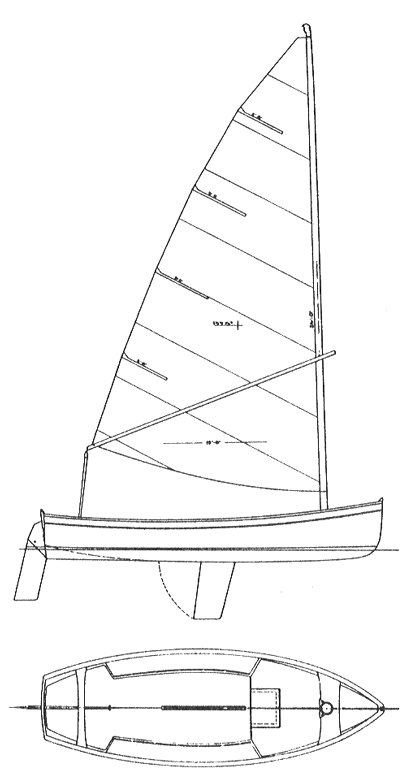
Naiad 18 for sale elsewhere on the web:

Main features
Login or register to personnalize this screen.
You will be able to pin external links of your choice.

See how Sailboatlab works in video

We help you build your own hydraulic steering system - Lecomble & Schmitt
Accommodations
Builder data, modal title.
The content of your modal.
Personalize your sailboat data sheet
- Boats for Sale
- Najad Yachts
New and used Najad Yachts for sale
- Netherlands
- United Kingdom
- United States
- Najad Yachts 330
- Najad Yachts 331
- Najad Yachts 332
- Najad Yachts 34
- Najad Yachts 355
- Najad Yachts 360
- Najad Yachts 361
- Najad Yachts 370
- Najad Yachts 380
- Najad Yachts 390
- Najad Yachts 391
- Najad Yachts 400
- Najad Yachts 405
- Najad Yachts 410
- Najad Yachts 420
- Najad Yachts 440 CC
- Najad Yachts 441
- Najad Yachts 460
- Najad Yachts 490
- Najad Yachts 505
- Najad Yachts Aphrodite 51

Search for a Najad Yachts on the worlds largest network. We have Najad Yachts brokers and sellers from around the world at great prices.
History of Najad Yachts
Established in 1971, Najad Yachts has been a stalwart name in the world of seafaring for half a century. The renowned company began its journey in Henån, a small town on the island of Orust, in the heart of Sweden's boating district. The founders, Berndt Arvidsson and Roland Svensson had one goal in mind: to create robust, sea-worthy sailing yachts for global voyagers. This philosophy was reflected in the choice of the brand's name 'Najad', derived from the mythical sea nymphs - evident of the company's inherent connection with maritime exploration.
Over the decades, numerous advancements in technology have allowed Najad Yachts to constantly improve and perfect their boat craftsmanship. Today, Najad Yachts is globally recognised for its range of yachts that effortlessly combine elegance, comfort, and safety. They are known for their excellent sailing performance, strong seaworthiness, and exquisite Scandinavian craftsmanship. With a reputation for creating customised, luxury yachts, Najad has become the epitome of quality and has left an indelible mark in the world of sailing.
In 2018, Najad Yachts was acquired by Arcona Yachts, another prestigious Swedish boat manufacturer. The company currently resides in Uddevalla, a coastal town north of its original birthplace. Despite the shift in ownership and location, the essence of Najad Yachts remains intact. Embracing a blend of tradition and innovation, the company continues to create yachts that are designed to stand the test of time and endure all marine conditions. The spirit of Najad, its commitment to quality, and its legacy of seaward excellence are truly timeless.
Which models do Najad Yachts produce?
Najad Yachts produce a range of boats including the Najad Yachts 370 , Najad Yachts 460 , Najad Yachts 380 , Najad Yachts 391 and Najad Yachts 410 . For the full list of Najad Yachts models currently listed on TheYachtMarket.com, see the model list in the search options on this page.
What types of boats do Najad Yachts build?
Najad Yachts manufactures a range of different types of boats. The ones listed on TheYachtMarket include Sloop , Cruiser , Aft cabin , Centre cockpit and Antique/classic .
How much does a boat from Najad Yachts cost?
Used boats from Najad Yachts on TheYachtMarket.com range in price from £34,300 GBP to £515,000 GBP with an average price of £182,000 GBP . A wide range of factors can affect the price of used boats from Najad Yachts, for example the model, age and condition.
Sign up to our newsletter
By submitting this form, you agree to our Privacy & Cookie Policy
Change units of measure
This feature requires cookies to be enabled on your browser.
Show price in:
Show lengths, beam and draft in:
Show displacement or weight in:
Show capacity or volume in:
Show speed in:
Show distance in:

- Membership Benefits
- Advice for Potential Buyers
- Inspiration Documents
- Friends of INA
- Misc. Boat Data
- Nonsuch Marketing Videos
- Regional Associations
- To place an ad members start here
- Marketplace Guide
- Nonsuch 22(s) for sale
- Nonsuch 26(s) & 260(s) for sale
- Nonsuch 30(s) & 324(s) for sale
- Nonsuch 33(s), 354(s) & 36(s) for sale
- Naiad, Nereus, Nighthawks for sale
- Items for Sale
- Boats/Items Wanted
- Marketplace
- Naiad 18 for sale (Patlak)

F I R S T I N C A T A M A R A N S
- 1-360-457-5752

- RecPro | Recreational
- PaxCat | Passenger
- LabCat | Survey
- Landing Craft

Rigid Hull Inflatable Boats
NAIAD – 4WD OF THE SEA
Building a rhib or foam fendered workboat is a highly specialized craft in which experience is invaluable..
That’s why Naiad has become the brand of choice in the commercial, government or military sectors. In its 30 plus years, the company has built more than 1200 boats for customers in every corner of the world looking for quality over compromise. Where other boats struggle in rough conditions, a Naiad gets the job done comfortably and safely, earning its reputation as the 4WD of the sea.

NAIAD Website
NAIAD Brochure

RHIB Tourism
Rhib tourism vessels.
Naiad has designed many eye-catching vessels specifically for tourism operators, never compromising on safety or reliability. Apart from the renowned low operating costs on a lineup of vessels from 8m to 14m, customizations are available on each Naiad to suit any particular purpose. A bow-boarding feature enables the operator to fold down a section of the bow fender, after which in-built steps provide passengers safe and easy access for beach landings. From eco-touring to whale watching, diving charters to water taxis, Naiad has the designs to perform virtually any activity.
- 6.8M – 8 Passenger (22′)
- 8M – 10 Passenger (26′)
- 10M – 12 Passenger (32′)
- 11.3M – 12 – 30 Passengers (37′)
- 12.6M – 30 – 40 Passengers (41′)
- 14M – Up to 50 Passengers (46′)
www.naiad.co.nz

RHIB Patrol
A comfortable, safe boat is paramount for operators to carry out their duties efficiently and safely. That’s why Naiad focuses so intently on hull design. A technically superior, soft riding hull shape, combined with advanced shock-mitigating seat design means Naiad Patrol Boats are capable of higher speeds in rougher water with less potential for injury or fatigue. Furthermore, a Naiad’s design makes it easier to track cleanly through waves and manoeuvre with confidence, so boarding other vessels is easier, more predictable and safer. Naiad Patrol Boats are currently deployed by Police, Fisheries, Navy dive units, Harbour Masters, Port Security and Customs in locations all around the world and the range includes centre console, walk-thru centre cabin, hardtop and full cabin.
- Open Boats: 5.8M – 10M (19′ – 32′)
- Hardtops: 7M – 10M (22′ – 32′)
- Full Cabin: 7M -15M (22′ – 50′)
- Outboard – Single / Twin / Triple
- Diesel Jet – Single / Twin
- Diesel Shaft – Twin

RHIB Rescue
Rhib rescue vessels.
Rescue crews are often called out when conditions are at their worst. So it goes without saying they need a boat that will get them to an incident quickly and back home safely. The strength and performance of Naiad has been well proven by our many rescue and military customers from all parts of the world. But it’s closer to home, in some of the most challenging sea conditions anywhere, that Naiad has established its reputation. In fact, more than 60 boats have been delivered to Coastguard New Zealand, and 50 Naiads now operate as rescue boats throughout Australia.

RHIB Pilot Vessels
- Recent Build
When coming alongside a ship at up to 18 knots, safe, predictable handling is vital. And that’s exactly what Naiad does best. From the 9.5m twin outboard our range of pilot boats goes up to a 23m twin diesel shaft drive with specially isolated crew cabin. (You’ll be amazed at how incredibly quiet it is in this cabin – just 66dB at cruise speed). In between, Naiad also has 11.3m, 12.6m, 14.9m and 17.3m designs available. Featuring a D-shaped fender system consisting of laminated closed-cell foam coated with a tough polyurethane skin, all Naiad Pilot Boats are built to endure “controlled collisions” day-in, day out.
- 9.5M Twin Outboard (31′)
- 11.3M Sterdrive (37′)
- 12.6M Twin Outboard (41′)
- 12.6M Twin Diesel Shaft (41′)
- 4.9M Twin Diesel Shaft, Isolated Cabin Optional (16′)
- 17.3M Twin Diesel Shaft, with Isolated Cabin (56′)
- 23M Twin Diesel Shaft, with Isolated Cabin (75′)
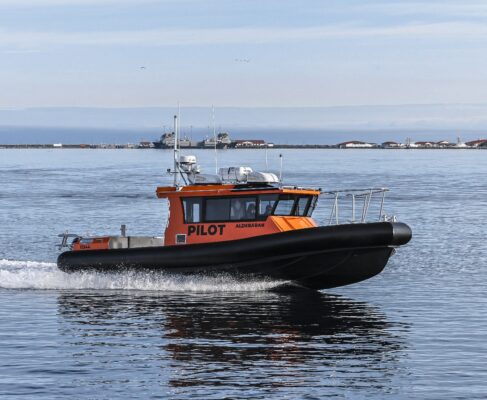
BRIX Marine Launches The Aldebaran: The Latest Addition to the NAIAD Vessel Series
Port Angeles, WA — BRIX Marine, a renowned leader in marine craftsmanship, proudly announces the [...]
RHIB Tenders
Favoured by owners and captains alike, a Naiad tender is capable of handling harsh conditions yet sacrifices nothing in terms of style, comfort and quality. Every yacht tender we design is customised. Finished to the highest standards they can include teak decks, luxury upholstery, gleaming stainless fittings, even full parasailing kits, making these boats very much at home on the most elegant superyacht. Ranging from 5.8m to 14m, you can also select from a wide choice of engine and propulsion options. From a simple, single outboard all the way through to twin diesel jets. In fact, some of our smaller boats can even be fitted with diesel jets. No wonder the fleet of Naiad superyacht tenders is growing fast, all over the world!
- Open Boats: 5.8M – 14M (19′ – 46′)
- Full Cabin: 10M -14M (32′ – 46′)
- Diesel Shaft – Single / Twin
maths problem solving word problems
- Math Word Problems
Welcome to the math word problems worksheets page at Math-Drills.com! On this page, you will find Math word and story problems worksheets with single- and multi-step solutions on a variety of math topics including addition, multiplication, subtraction, division and other math topics. It is usually a good idea to ensure students already have a strategy or two in place to complete the math operations involved in a particular question. For example, students may need a way to figure out what 7 × 8 is or have previously memorized the answer before you give them a word problem that involves finding the answer to 7 × 8.
There are a number of strategies used in solving math word problems; if you don't have a favorite, try the Math-Drills.com problem-solving strategy:
- Question : Understand what the question is asking. What operation or operations do you need to use to solve this question? Ask for help to understand the question if you can't do it on your own.
- Estimate : Use an estimation strategy, so you can check your answer for reasonableness in the evaluate step. Try underestimating and overestimating, so you know what range the answer is supposed to be in. Be flexible in rounding numbers if it will make your estimate easier.
- Strategize : Choose a strategy to solve the problem. Will you use mental math, manipulatives, or pencil and paper? Use a strategy that works for you. Save the calculator until the evaluate stage.
- Calculate : Use your strategy to solve the problem.
- Evaluate : Compare your answer to your estimate. If you under and overestimated, is the answer in the correct range. If you rounded up or down, does the answer make sense (e.g. is it a little less or a little more than the estimate). Also check with a calculator.
Most Popular Math Word Problems this Week
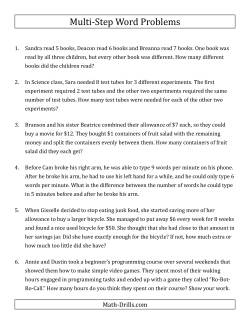
Arithmetic Word Problems
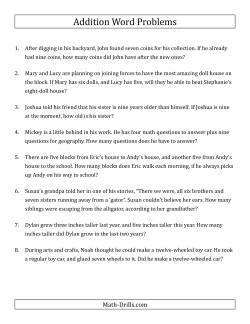
- Addition Word Problems One-Step Addition Word Problems Using Single-Digit Numbers One-Step Addition Word Problems Using Two-Digit Numbers
- Subtraction Word Problems Subtraction Facts Word Problems With Differences from 5 to 12
- Multiplication Word Problems One-Step Multiplication Word Problems up to 10 × 10
- Division Word Problems Division Facts Word Problems with Quotients from 5 to 12
- Multi-Step Word Problems Easy Multi-Step Word Problems
Copyright © 2005-2024 Math-Drills.com You may use the math worksheets on this website according to our Terms of Use to help students learn math.
- Prodigy Math
- Prodigy English
From our blog
- Is a Premium Membership Worth It?
- Promote a Growth Mindset
- Help Your Child Who's Struggling with Math
- Parent's Guide to Prodigy
- Assessments
- Math Curriculum Coverage
- English Curriculum Coverage
- Game Portal
120 Math Word Problems To Challenge Students Grades 1 to 8

Written by Marcus Guido
Hey teachers! 👋
Use Prodigy to spark a love for math in your students – including when solving word problems!
- Teaching Tools
- Subtraction
- Multiplication
- Mixed operations
- Ordering and number sense
- Comparing and sequencing
- Physical measurement
- Ratios and percentages
- Probability and data relationships
You sit at your desk, ready to put a math quiz, test or activity together. The questions flow onto the document until you hit a section for word problems.
A jolt of creativity would help. But it doesn’t come.
Whether you’re a 3rd grade teacher or an 8th grade teacher preparing students for high school, translating math concepts into real world examples can certainly be a challenge.
This resource is your jolt of creativity. It provides examples and templates of math word problems for 1st to 8th grade classes.
There are 120 examples in total.
The list of examples is supplemented by tips to create engaging and challenging math word problems.
120 Math word problems, categorized by skill
Addition word problems.

Best for: 1st grade, 2nd grade
1. Adding to 10: Ariel was playing basketball. 1 of her shots went in the hoop. 2 of her shots did not go in the hoop. How many shots were there in total?
2. Adding to 20: Adrianna has 10 pieces of gum to share with her friends. There wasn’t enough gum for all her friends, so she went to the store to get 3 more pieces of gum. How many pieces of gum does Adrianna have now?
3. Adding to 100: Adrianna has 10 pieces of gum to share with her friends. There wasn’t enough gum for all her friends, so she went to the store and got 70 pieces of strawberry gum and 10 pieces of bubble gum. How many pieces of gum does Adrianna have now?
4. Adding Slightly over 100: The restaurant has 175 normal chairs and 20 chairs for babies. How many chairs does the restaurant have in total?
5. Adding to 1,000: How many cookies did you sell if you sold 320 chocolate cookies and 270 vanilla cookies?
6. Adding to and over 10,000: The hobby store normally sells 10,576 trading cards per month. In June, the hobby store sold 15,498 more trading cards than normal. In total, how many trading cards did the hobby store sell in June?
7. Adding 3 Numbers: Billy had 2 books at home. He went to the library to take out 2 more books. He then bought 1 book. How many books does Billy have now?
8. Adding 3 Numbers to and over 100: Ashley bought a big bag of candy. The bag had 102 blue candies, 100 red candies and 94 green candies. How many candies were there in total?
Subtraction word problems
Best for: 1st grade, second grade
9. Subtracting to 10: There were 3 pizzas in total at the pizza shop. A customer bought 1 pizza. How many pizzas are left?
10. Subtracting to 20: Your friend said she had 11 stickers. When you helped her clean her desk, she only had a total of 10 stickers. How many stickers are missing?
11. Subtracting to 100: Adrianna has 100 pieces of gum to share with her friends. When she went to the park, she shared 10 pieces of strawberry gum. When she left the park, Adrianna shared another 10 pieces of bubble gum. How many pieces of gum does Adrianna have now?

Practice math word problems with Prodigy Math
Join millions of teachers using Prodigy to make learning fun and differentiate instruction as they answer in-game questions, including math word problems from 1st to 8th grade!
12. Subtracting Slightly over 100: Your team scored a total of 123 points. 67 points were scored in the first half. How many were scored in the second half?
13. Subtracting to 1,000: Nathan has a big ant farm. He decided to sell some of his ants. He started with 965 ants. He sold 213. How many ants does he have now?
14. Subtracting to and over 10,000: The hobby store normally sells 10,576 trading cards per month. In July, the hobby store sold a total of 20,777 trading cards. How many more trading cards did the hobby store sell in July compared with a normal month?
15. Subtracting 3 Numbers: Charlene had a pack of 35 pencil crayons. She gave 6 to her friend Theresa. She gave 3 to her friend Mandy. How many pencil crayons does Charlene have left?
16. Subtracting 3 Numbers to and over 100: Ashley bought a big bag of candy to share with her friends. In total, there were 296 candies. She gave 105 candies to Marissa. She also gave 86 candies to Kayla. How many candies were left?
Multiplication word problems
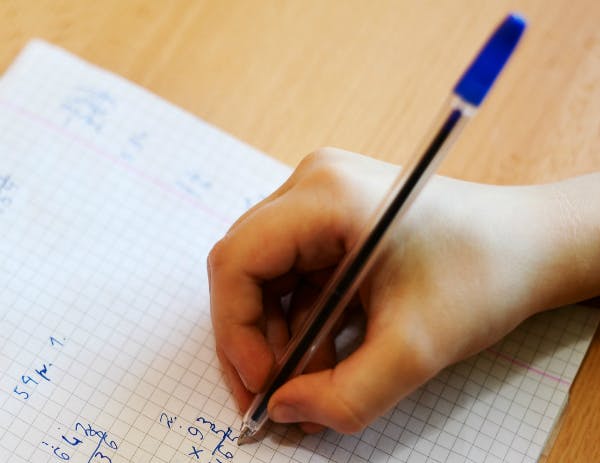
Best for: 2nd grade, 3rd grade
17. Multiplying 1-Digit Integers: Adrianna needs to cut a pan of brownies into pieces. She cuts 6 even columns and 3 even rows into the pan. How many brownies does she have?
18. Multiplying 2-Digit Integers: A movie theatre has 25 rows of seats with 20 seats in each row. How many seats are there in total?
19. Multiplying Integers Ending with 0: A clothing company has 4 different kinds of sweatshirts. Each year, the company makes 60,000 of each kind of sweatshirt. How many sweatshirts does the company make each year?
20. Multiplying 3 Integers: A bricklayer stacks bricks in 2 rows, with 10 bricks in each row. On top of each row, there is a stack of 6 bricks. How many bricks are there in total?
21. Multiplying 4 Integers: Cayley earns $5 an hour by delivering newspapers. She delivers newspapers 3 days each week, for 4 hours at a time. After delivering newspapers for 8 weeks, how much money will Cayley earn?
Division word problems
Best for: 3rd grade, 4th grade, 5th grade
22. Dividing 1-Digit Integers: If you have 4 pieces of candy split evenly into 2 bags, how many pieces of candy are in each bag?
23. Dividing 2-Digit Integers: If you have 80 tickets for the fair and each ride costs 5 tickets, how many rides can you go on?
24. Dividing Numbers Ending with 0: The school has $20,000 to buy new computer equipment. If each piece of equipment costs $50, how many pieces can the school buy in total?
25. Dividing 3 Integers: Melissa buys 2 packs of tennis balls for $12 in total. All together, there are 6 tennis balls. How much does 1 pack of tennis balls cost? How much does 1 tennis ball cost?
26. Interpreting Remainders: An Italian restaurant receives a shipment of 86 veal cutlets. If it takes 3 cutlets to make a dish, how many cutlets will the restaurant have left over after making as many dishes as possible?
Mixed operations word problems

27. Mixing Addition and Subtraction: There are 235 books in a library. On Monday, 123 books are taken out. On Tuesday, 56 books are brought back. How many books are there now?
28. Mixing Multiplication and Division: There is a group of 10 people who are ordering pizza. If each person gets 2 slices and each pizza has 4 slices, how many pizzas should they order?
29. Mixing Multiplication, Addition and Subtraction: Lana has 2 bags with 2 marbles in each bag. Markus has 2 bags with 3 marbles in each bag. How many more marbles does Markus have?
30. Mixing Division, Addition and Subtraction: Lana has 3 bags with the same amount of marbles in them, totaling 12 marbles. Markus has 3 bags with the same amount of marbles in them, totaling 18 marbles. How many more marbles does Markus have in each bag?
Ordering and number sense word problems
31. Counting to Preview Multiplication: There are 2 chalkboards in your classroom. If each chalkboard needs 2 pieces of chalk, how many pieces do you need in total?
32. Counting to Preview Division: There are 3 chalkboards in your classroom. Each chalkboard has 2 pieces of chalk. This means there are 6 pieces of chalk in total. If you take 1 piece of chalk away from each chalkboard, how many will there be in total?
33. Composing Numbers: What number is 6 tens and 10 ones?
34. Guessing Numbers: I have a 7 in the tens place. I have an even number in the ones place. I am lower than 74. What number am I?
35. Finding the Order: In the hockey game, Mitchell scored more points than William but fewer points than Auston. Who scored the most points? Who scored the fewest points?
Fractions word problems

Best for: 3rd grade, 4th grade, 5th grade, 6th grade
36. Finding Fractions of a Group: Julia went to 10 houses on her street for Halloween. 5 of the houses gave her a chocolate bar. What fraction of houses on Julia’s street gave her a chocolate bar?
37. Finding Unit Fractions: Heather is painting a portrait of her best friend, Lisa. To make it easier, she divides the portrait into 6 equal parts. What fraction represents each part of the portrait?
38. Adding Fractions with Like Denominators: Noah walks ⅓ of a kilometre to school each day. He also walks ⅓ of a kilometre to get home after school. How many kilometres does he walk in total?
39. Subtracting Fractions with Like Denominators: Last week, Whitney counted the number of juice boxes she had for school lunches. She had ⅗ of a case. This week, it’s down to ⅕ of a case. How much of the case did Whitney drink?
40. Adding Whole Numbers and Fractions with Like Denominators: At lunchtime, an ice cream parlor served 6 ¼ scoops of chocolate ice cream, 5 ¾ scoops of vanilla and 2 ¾ scoops of strawberry. How many scoops of ice cream did the parlor serve in total?
41. Subtracting Whole Numbers and Fractions with Like Denominators: For a party, Jaime had 5 ⅓ bottles of cola for her friends to drink. She drank ⅓ of a bottle herself. Her friends drank 3 ⅓. How many bottles of cola does Jaime have left?
42. Adding Fractions with Unlike Denominators: Kevin completed ½ of an assignment at school. When he was home that evening, he completed ⅚ of another assignment. How many assignments did Kevin complete?
43. Subtracting Fractions with Unlike Denominators: Packing school lunches for her kids, Patty used ⅞ of a package of ham. She also used ½ of a package of turkey. How much more ham than turkey did Patty use?
44. Multiplying Fractions: During gym class on Wednesday, the students ran for ¼ of a kilometre. On Thursday, they ran ½ as many kilometres as on Wednesday. How many kilometres did the students run on Thursday? Write your answer as a fraction.
45. Dividing Fractions: A clothing manufacturer uses ⅕ of a bottle of colour dye to make one pair of pants. The manufacturer used ⅘ of a bottle yesterday. How many pairs of pants did the manufacturer make?
46. Multiplying Fractions with Whole Numbers: Mark drank ⅚ of a carton of milk this week. Frank drank 7 times more milk than Mark. How many cartons of milk did Frank drink? Write your answer as a fraction, or as a whole or mixed number.
Decimals word problems
Best for: 4th grade, 5th grade
47. Adding Decimals: You have 2.6 grams of yogurt in your bowl and you add another spoonful of 1.3 grams. How much yogurt do you have in total?
48. Subtracting Decimals: Gemma had 25.75 grams of frosting to make a cake. She decided to use only 15.5 grams of the frosting. How much frosting does Gemma have left?
49. Multiplying Decimals with Whole Numbers: Marshall walks a total of 0.9 kilometres to and from school each day. After 4 days, how many kilometres will he have walked?
50. Dividing Decimals by Whole Numbers: To make the Leaning Tower of Pisa from spaghetti, Mrs. Robinson bought 2.5 kilograms of spaghetti. Her students were able to make 10 leaning towers in total. How many kilograms of spaghetti does it take to make 1 leaning tower?
51. Mixing Addition and Subtraction of Decimals: Rocco has 1.5 litres of orange soda and 2.25 litres of grape soda in his fridge. Antonio has 1.15 litres of orange soda and 0.62 litres of grape soda. How much more soda does Rocco have than Angelo?
52. Mixing Multiplication and Division of Decimals: 4 days a week, Laura practices martial arts for 1.5 hours. Considering a week is 7 days, what is her average practice time per day each week?
Comparing and sequencing word problems

Best for: Kindergarten, 1st grade, 2nd grade
53. Comparing 1-Digit Integers: You have 3 apples and your friend has 5 apples. Who has more?
54. Comparing 2-Digit Integers: You have 50 candies and your friend has 75 candies. Who has more?
55. Comparing Different Variables: There are 5 basketballs on the playground. There are 7 footballs on the playground. Are there more basketballs or footballs?
56. Sequencing 1-Digit Integers: Erik has 0 stickers. Every day he gets 1 more sticker. How many days until he gets 3 stickers?
57. Skip-Counting by Odd Numbers: Natalie began at 5. She skip-counted by fives. Could she have said the number 20?
58. Skip-Counting by Even Numbers: Natasha began at 0. She skip-counted by eights. Could she have said the number 36?
59. Sequencing 2-Digit Numbers: Each month, Jeremy adds the same number of cards to his baseball card collection. In January, he had 36. 48 in February. 60 in March. How many baseball cards will Jeremy have in April?
Time word problems
66. Converting Hours into Minutes: Jeremy helped his mom for 1 hour. For how many minutes was he helping her?
69. Adding Time: If you wake up at 7:00 a.m. and it takes you 1 hour and 30 minutes to get ready and walk to school, at what time will you get to school?
70. Subtracting Time: If a train departs at 2:00 p.m. and arrives at 4:00 p.m., how long were passengers on the train for?
71. Finding Start and End Times: Rebecca left her dad’s store to go home at twenty to seven in the evening. Forty minutes later, she was home. What time was it when she arrived home?
Money word problems
Best for: 1st grade, 2nd grade, 3rd grade, 4th grade, 5th grade
60. Adding Money: Thomas and Matthew are saving up money to buy a video game together. Thomas has saved $30. Matthew has saved $35. How much money have they saved up together in total?
61. Subtracting Money: Thomas has $80 saved up. He uses his money to buy a video game. The video game costs $67. How much money does he have left?
62. Multiplying Money: Tim gets $5 for delivering the paper. How much money will he have after delivering the paper 3 times?
63. Dividing Money: Robert spent $184.59 to buy 3 hockey sticks. If each hockey stick was the same price, how much did 1 cost?
64. Adding Money with Decimals: You went to the store and bought gum for $1.25 and a sucker for $0.50. How much was your total?
65. Subtracting Money with Decimals: You went to the store with $5.50. You bought gum for $1.25, a chocolate bar for $1.15 and a sucker for $0.50. How much money do you have left?
67. Applying Proportional Relationships to Money: Jakob wants to invite 20 friends to his birthday, which will cost his parents $250. If he decides to invite 15 friends instead, how much money will it cost his parents? Assume the relationship is directly proportional.
68. Applying Percentages to Money: Retta put $100.00 in a bank account that gains 20% interest annually. How much interest will be accumulated in 1 year? And if she makes no withdrawals, how much money will be in the account after 1 year?
Physical measurement word problems

Best for: 1st grade, 2nd grade, 3rd grade, 4th grade
72. Comparing Measurements: Cassandra’s ruler is 22 centimetres long. April’s ruler is 30 centimetres long. How many centimetres longer is April’s ruler?
73. Contextualizing Measurements: Picture a school bus. Which unit of measurement would best describe the length of the bus? Centimetres, metres or kilometres?
74. Adding Measurements: Micha’s dad wants to try to save money on gas, so he has been tracking how much he uses. Last year, Micha’s dad used 100 litres of gas. This year, her dad used 90 litres of gas. How much gas did he use in total for the two years?
75. Subtracting Measurements: Micha’s dad wants to try to save money on gas, so he has been tracking how much he uses. Over the past two years, Micha’s dad used 200 litres of gas. This year, he used 100 litres of gas. How much gas did he use last year?

76. Multiplying Volume and Mass: Kiera wants to make sure she has strong bones, so she drinks 2 litres of milk every week. After 3 weeks, how many litres of milk will Kiera drink?
77. Dividing Volume and Mass: Lillian is doing some gardening, so she bought 1 kilogram of soil. She wants to spread the soil evenly between her 2 plants. How much will each plant get?
78. Converting Mass: Inger goes to the grocery store and buys 3 squashes that each weigh 500 grams. How many kilograms of squash did Inger buy?
79. Converting Volume: Shad has a lemonade stand and sold 20 cups of lemonade. Each cup was 500 millilitres. How many litres did Shad sell in total?
80. Converting Length: Stacy and Milda are comparing their heights. Stacy is 1.5 meters tall. Milda is 10 centimetres taller than Stacy. What is Milda’s height in centimetres?
81. Understanding Distance and Direction: A bus leaves the school to take students on a field trip. The bus travels 10 kilometres south, 10 kilometres west, another 5 kilometres south and 15 kilometres north. To return to the school, in which direction does the bus have to travel? How many kilometres must it travel in that direction?
Ratios and percentages word problems
Best for: 4th grade, 5th grade, 6th grade
82. Finding a Missing Number: The ratio of Jenny’s trophies to Meredith’s trophies is 7:4. Jenny has 28 trophies. How many does Meredith have?
83. Finding Missing Numbers: The ratio of Jenny’s trophies to Meredith’s trophies is 7:4. The difference between the numbers is 12. What are the numbers?
84. Comparing Ratios: The school’s junior band has 10 saxophone players and 20 trumpet players. The school’s senior band has 18 saxophone players and 29 trumpet players. Which band has the higher ratio of trumpet to saxophone players?
85. Determining Percentages: Mary surveyed students in her school to find out what their favourite sports were. Out of 1,200 students, 455 said hockey was their favourite sport. What percentage of students said hockey was their favourite sport?
86. Determining Percent of Change: A decade ago, Oakville’s population was 67,624 people. Now, it is 190% larger. What is Oakville’s current population?
87. Determining Percents of Numbers: At the ice skate rental stand, 60% of 120 skates are for boys. If the rest of the skates are for girls, how many are there?
88. Calculating Averages: For 4 weeks, William volunteered as a helper for swimming classes. The first week, he volunteered for 8 hours. He volunteered for 12 hours in the second week, and another 12 hours in the third week. The fourth week, he volunteered for 9 hours. For how many hours did he volunteer per week, on average?
Probability and data relationships word problems

Best for: 4th grade, 5th grade, 6th grade, 7th grade
89. Understanding the Premise of Probability: John wants to know his class’s favourite TV show, so he surveys all of the boys. Will the sample be representative or biased?
90. Understanding Tangible Probability: The faces on a fair number die are labelled 1, 2, 3, 4, 5 and 6. You roll the die 12 times. How many times should you expect to roll a 1?
91. Exploring Complementary Events: The numbers 1 to 50 are in a hat. If the probability of drawing an even number is 25/50, what is the probability of NOT drawing an even number? Express this probability as a fraction.
92. Exploring Experimental Probability: A pizza shop has recently sold 15 pizzas. 5 of those pizzas were pepperoni. Answering with a fraction, what is the experimental probability that he next pizza will be pepperoni?
93. Introducing Data Relationships: Maurita and Felice each take 4 tests. Here are the results of Maurita’s 4 tests: 4, 4, 4, 4. Here are the results for 3 of Felice’s 4 tests: 3, 3, 3. If Maurita’s mean for the 4 tests is 1 point higher than Felice’s, what’s the score of Felice’s 4th test?
94. Introducing Proportional Relationships: Store A is selling 7 pounds of bananas for $7.00. Store B is selling 3 pounds of bananas for $6.00. Which store has the better deal?
95. Writing Equations for Proportional Relationships: Lionel loves soccer, but has trouble motivating himself to practice. So, he incentivizes himself through video games. There is a proportional relationship between the amount of drills Lionel completes, in x , and for how many hours he plays video games, in y . When Lionel completes 10 drills, he plays video games for 30 minutes. Write the equation for the relationship between x and y .
Geometry word problems
Best for: 4th grade, 5th grade, 6th grade, 7th grade, 8th grade
96. Introducing Perimeter: The theatre has 4 chairs in a row. There are 5 rows. Using rows as your unit of measurement, what is the perimeter?
97. Introducing Area: The theatre has 4 chairs in a row. There are 5 rows. How many chairs are there in total?
98. Introducing Volume: Aaron wants to know how much candy his container can hold. The container is 20 centimetres tall, 10 centimetres long and 10 centimetres wide. What is the container’s volume?
99. Understanding 2D Shapes: Kevin draws a shape with 4 equal sides. What shape did he draw?
100. Finding the Perimeter of 2D Shapes: Mitchell wrote his homework questions on a piece of square paper. Each side of the paper is 8 centimetres. What is the perimeter?
101. Determining the Area of 2D Shapes: A single trading card is 9 centimetres long by 6 centimetres wide. What is its area?
102. Understanding 3D Shapes: Martha draws a shape that has 6 square faces. What shape did she draw?
103. Determining the Surface Area of 3D Shapes: What is the surface area of a cube that has a width of 2cm, height of 2 cm and length of 2 cm?
104. Determining the Volume of 3D Shapes: Aaron’s candy container is 20 centimetres tall, 10 centimetres long and 10 centimetres wide. Bruce’s container is 25 centimetres tall, 9 centimetres long and 9 centimetres wide. Find the volume of each container. Based on volume, whose container can hold more candy?
105. Identifying Right-Angled Triangles: A triangle has the following side lengths: 3 cm, 4 cm and 5 cm. Is this triangle a right-angled triangle?
106. Identifying Equilateral Triangles: A triangle has the following side lengths: 4 cm, 4 cm and 4 cm. What kind of triangle is it?
107. Identifying Isosceles Triangles: A triangle has the following side lengths: 4 cm, 5 cm and 5 cm. What kind of triangle is it?
108. Identifying Scalene Triangles: A triangle has the following side lengths: 4 cm, 5 cm and 6 cm. What kind of triangle is it?
109. Finding the Perimeter of Triangles: Luigi built a tent in the shape of an equilateral triangle. The perimeter is 21 metres. What is the length of each of the tent’s sides?
110. Determining the Area of Triangles: What is the area of a triangle with a base of 2 units and a height of 3 units?
111. Applying Pythagorean Theorem: A right triangle has one non-hypotenuse side length of 3 inches and the hypotenuse measures 5 inches. What is the length of the other non-hypotenuse side?
112. Finding a Circle’s Diameter: Jasmin bought a new round backpack. Its area is 370 square centimetres. What is the round backpack’s diameter?
113. Finding a Circle's Area: Captain America’s circular shield has a diameter of 76.2 centimetres. What is the area of his shield?
114. Finding a Circle’s Radius: Skylar lives on a farm, where his dad keeps a circular corn maze. The corn maze has a diameter of 2 kilometres. What is the maze’s radius?
Variables word problems
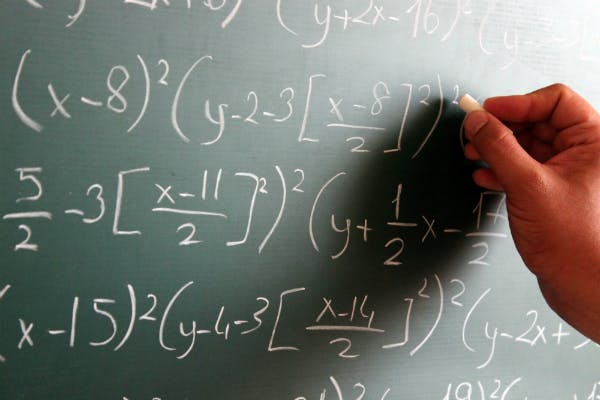
Best for: 6th grade, 7th grade, 8th grade
115. Identifying Independent and Dependent Variables: Victoria is baking muffins for her class. The number of muffins she makes is based on how many classmates she has. For this equation, m is the number of muffins and c is the number of classmates. Which variable is independent and which variable is dependent?
116. Writing Variable Expressions for Addition: Last soccer season, Trish scored g goals. Alexa scored 4 more goals than Trish. Write an expression that shows how many goals Alexa scored.
117. Writing Variable Expressions for Subtraction: Elizabeth eats a healthy, balanced breakfast b times a week. Madison sometimes skips breakfast. In total, Madison eats 3 fewer breakfasts a week than Elizabeth. Write an expression that shows how many times a week Madison eats breakfast.
118. Writing Variable Expressions for Multiplication: Last hockey season, Jack scored g goals. Patrik scored twice as many goals than Jack. Write an expression that shows how many goals Patrik scored.
119. Writing Variable Expressions for Division: Amanda has c chocolate bars. She wants to distribute the chocolate bars evenly among 3 friends. Write an expression that shows how many chocolate bars 1 of her friends will receive.
120. Solving Two-Variable Equations: This equation shows how the amount Lucas earns from his after-school job depends on how many hours he works: e = 12h . The variable h represents how many hours he works. The variable e represents how much money he earns. How much money will Lucas earn after working for 6 hours?
How to easily make your own math word problems & word problems worksheets

Armed with 120 examples to spark ideas, making your own math word problems can engage your students and ensure alignment with lessons. Do:
- Link to Student Interests: By framing your word problems with student interests, you’ll likely grab attention. For example, if most of your class loves American football, a measurement problem could involve the throwing distance of a famous quarterback.
- Make Questions Topical: Writing a word problem that reflects current events or issues can engage students by giving them a clear, tangible way to apply their knowledge.
- Include Student Names: Naming a question’s characters after your students is an easy way make subject matter relatable, helping them work through the problem.
- Be Explicit: Repeating keywords distills the question, helping students focus on the core problem.
- Test Reading Comprehension: Flowery word choice and long sentences can hide a question’s key elements. Instead, use concise phrasing and grade-level vocabulary.
- Focus on Similar Interests: Framing too many questions with related interests -- such as football and basketball -- can alienate or disengage some students.
- Feature Red Herrings: Including unnecessary information introduces another problem-solving element, overwhelming many elementary students.
A key to differentiated instruction , word problems that students can relate to and contextualize will capture interest more than generic and abstract ones.
Final thoughts about math word problems
You’ll likely get the most out of this resource by using the problems as templates, slightly modifying them by applying the above tips. In doing so, they’ll be more relevant to -- and engaging for -- your students.
Regardless, having 120 curriculum-aligned math word problems at your fingertips should help you deliver skill-building challenges and thought-provoking assessments.
The result?
A greater understanding of how your students process content and demonstrate understanding, informing your ongoing teaching approach.

Child Login
- Kindergarten
- Number charts
- Skip Counting
- Place Value
- Number Lines
Word Problems
- Comparing Numbers
- Ordering Numbers
- Odd and Even
- Prime and Composite
- Roman Numerals
- Ordinal Numbers
- In and Out Boxes
- Number System Conversions
- More Number Sense Worksheets
- Size Comparison
- Measuring Length
- Metric Unit Conversion
- Customary Unit Conversion
- Temperature
- More Measurement Worksheets
- Writing Checks
- Profit and Loss
- Simple Interest
- Compound Interest
- Tally Marks
- Mean, Median, Mode, Range
- Mean Absolute Deviation
- Stem-and-leaf Plot
- Box-and-whisker Plot
- Permutation and Combination
- Probability
- Venn Diagram
- More Statistics Worksheets
- Shapes - 2D
- Shapes - 3D
- Lines, Rays and Line Segments
- Points, Lines and Planes
- Transformation
- Quadrilateral
- Ordered Pairs
- Midpoint Formula
- Distance Formula
- Parallel, Perpendicular and Intersecting Lines
- Scale Factor
- Surface Area
- Pythagorean Theorem
- More Geometry Worksheets
- Converting between Fractions and Decimals
- Significant Figures
- Convert between Fractions, Decimals, and Percents
- Proportions
- Direct and Inverse Variation
- Order of Operations
- Squaring Numbers
- Square Roots
- Scientific Notations
- Speed, Distance, and Time
- Absolute Value
- More Pre-Algebra Worksheets
- Translating Algebraic Phrases
- Evaluating Algebraic Expressions
- Simplifying Algebraic Expressions
- Algebraic Identities
- Quadratic Equations
- Systems of Equations
- Polynomials
- Inequalities
- Sequence and Series
- Complex Numbers
- More Algebra Worksheets
- Trigonometry
- Math Workbooks
- English Language Arts
- Summer Review Packets
- Social Studies
- Holidays and Events
- Worksheets >
- Number Sense >
Math Word Problem Worksheets
Read, explore, and solve over 1000 math word problems based on addition, subtraction, multiplication, division, fraction, decimal, ratio and more. These word problems help children hone their reading and analytical skills; understand the real-life application of math operations and other math topics. Print our exclusive colorful theme-based worksheets for a fun-filled teaching experience! Use the answer key provided below each worksheet to assist children in verifying their solutions.
List of Word Problem Worksheets
Explore the word problem worksheets in detail.
Addition Word Problems
Have 'total' fun by adding up a wide range of addends displayed in these worksheets! Simple real-life scenarios form the basis of these addition word problem worksheets.
Subtraction Word Problems
Learning can be a huge 'take away'! Find the difference between the numbers provided in each subtraction word problem. Large number subtraction up to six-digits can also be found here.
Addition and Subtraction Word Problems
Bring on 'A' game with our addition and subtraction word problems! Read, analyze, and solve real-life scenarios based on adding and subtracting numbers as required.
Multiplication Word Problems
Get 'product'ive with over 100 highly engaging multiplication word problems! Find the product and use the answer key to verify your solution. Free worksheets are also available.
Division Word Problems
"Divide and conquer" this huge collection of division word problems. Exclusive worksheets are available for the division problem leaving no remainder and with the remainder.
Fraction Word Problems
Perform various mathematical operations to solve the umpteen number of word problems based on like and unlike fractions, proper and improper fractions, and mixed numbers.
Decimal Word Problems
Let's get to the 'point'! Add, subtract, multiply, and divide to solve these decimal word problems. A wide selection of printable worksheets is available in this section. Use the answer key to verify your answers.
Ratio Word problems
Double up your success ratio with these sets of word problems, which cover a multitude of topics like express in the ratio, reducing the ratio, part-to-part ratio, part-to-whole ratio and more.
Venn Diagram Word Problems - Two Sets
Help your children improve their data analysis skills with these well-researched Venn diagram word problem worksheets. Find the union, intersection, complement and difference of two sets.
Venn Diagram Word Problems - Three Sets
These Venn diagram word problems provide ample practice in real-life application of Venn diagram involving three sets. The worksheets containing the universal set are also included.
Equation Word Problems
The printable worksheets here feature exercises consisting of one-step, two-step and multi-step equation word problems involving fractions, decimals and integers. MCQs to test the knowledge acquired have also been included.
Sample Worksheets
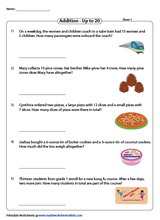
Become a Member
Membership Information
- Privacy Policy
What's New?
Printing Help
Testimonial
Copyright © 2024 - Math Worksheets 4 Kids
Teaching support from the UK’s largest provider of in-school maths tuition

resources downloaded

one to one lessons

schools supported
Mastery-Aligned Maths Tutoring
“The best thing has been the increase in confidence and tutors being there to deal with any misunderstandings straight away."
FREE daily maths challenges
A new KS2 maths challenge every day. Perfect as lesson starters - no prep required!

300 Primary School Maths Word Problems: Includes Examples And Answers
Sophie bartlett.
Solving word problems at KS1 and KS2 is an essential part of the new maths curriculum. Here you can find expert guidance on how to solve maths word problems as well as examples of the many different types of word problems primary school children will encounter with links to hundreds more .
What is a word problem?
Mastery helps children to explore maths in greater depth, how to teach children to solve word problems , word problems in year 1, word problems in year 2, word problems in year 3 , word problems in year 4, word problems in year 5, word problems in year 6, place value word problems, addition and subtraction word problems, multiplication and division word problems, fraction word problems, how important are word problems when it comes to the sats , remember: the word problems can change but the maths won’t .
A word problem in maths is a maths question written as one sentence or more that requires children to apply their maths knowledge to a ‘real-life’ scenario.
This means that children must be familiar with the vocabulary associated with the mathematical symbols they are used to, in order to make sense of the word problem.
For example:
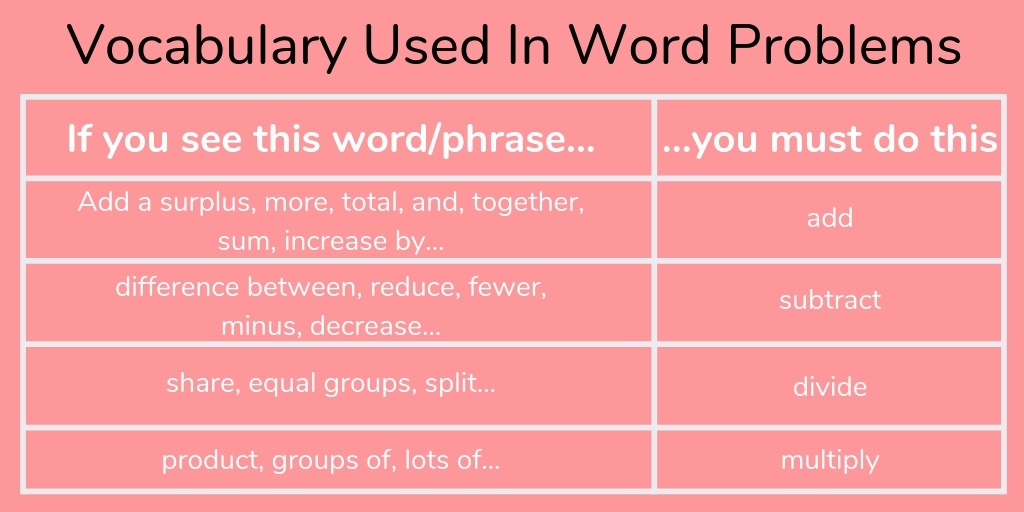
Importance of word problems within the national curriculum
The National Curriculum states that its mathematics curriculum “aims to ensure that all pupils:
- become fluent in the fundamentals of mathematics, including through varied and frequent practice with increasingly complex problems over time , so that pupils develop conceptual understanding and the ability to recall and apply knowledge rapidly and accurately;
- reason mathematically by following a line of enquiry, conjecturing relationships and generalisations, and developing an argument, justification or proof using mathematical language;
- can solve problems by applying their mathematics to a variety of routine and non-routine problems with increasing sophistication , including breaking down problems into a series of simpler steps and persevering in seeking solutions.”
To support this schools are adopting a ‘mastery’ approach to maths
The National Centre for Excellence in the Teaching of Mathematics (NCETM) have defined “teaching for mastery”, with some aspects of this definition being:
- Maths teaching for mastery rejects the idea that a large proportion of people ‘just can’t do maths’.
- All pupils are encouraged by the belief that by working hard at maths they can succeed.
- Procedural fluency and conceptual understanding are developed in tandem because each supports the development of the other.
- Significant time is spent developing deep knowledge of the key ideas that are needed to underpin future learning. The structure and connections within the mathematics are emphasised, so that pupils develop deep learning that can be sustained.
(The Essence of Maths Teaching for Mastery, 2016)
Year 3 to 6 Rapid Reasoning Worksheet for Weeks 1-6
Download for FREE 6 weeks of Rapid Reasoning worksheets. That include six weeks of daily reasoning and problem-solving questions for years 3, 4, 5 and 6!
One of NCETM’s Five Big Ideas in Teaching for Mastery (2017) is “ Mathematical Thinking: if taught ideas are to be understood deeply, they must not merely be passively received but must be worked on by the student: thought about, reasoned with and discussed with others”.
In other words – yes, fluency in arithmetic is important; however, with this often lies the common misconception that once a child has learnt the number skills appropriate to their level/age, they should be progressed to the next level/age of number skills.
The mastery approach encourages exploring the breadth and depth of these concepts (once fluency is secure) through reasoning and problem solving.
See the following example:
What sort of word problems might my child encounter at school.
In Key Stage 2, there are nine ‘strands’ of maths – these are then further split into ‘sub-strands’. For example, ‘number and place value’ is the first strand: a Year 3 sub-strand of this is to “find 10 or 100 more or less than a given number”; a Year 6 sub-strand of this is to “determine the value of each digit in numbers up to 10 million”. The table below shows how the ‘sub-strands’ are distributed across each strand and year group in KS2.
Here are two simple strategies that can be applied to many word problems before solving them.
- What do you already know?
- How can this problem be drawn/represented pictorially?
Let’s see how this can be applied to a word problem to help achieve the answer.
Solving a simple word problem
There are 28 pupils in a class. The teacher has 8 litres of orange juice. She pours 225 millilitres of orange juice for every pupil. How much orange juice is left over?
1. What do you already know?
- There are 1,000ml in 1 litre
- Pours = liquid leaving the bottle = subtraction
- For every = multiply
- Left over = requires subtraction at some point
2. How can this problem be drawn/represented pictorially?
The bar model is always a brilliant way of representing problems, but if you are not familiar with this, there are always other ways of drawing it out.
Read more: What is a bar model
For example, for this question, you could draw 28 pupils (or stick man x 28) with ‘225 ml’ above each one and then a half-empty bottle with ‘8 litres’ marked at the top.
Now to put the maths to work. This is a Year 6 multi-step problem, so we need to use what we already know and what we’ve drawn to break down the steps.
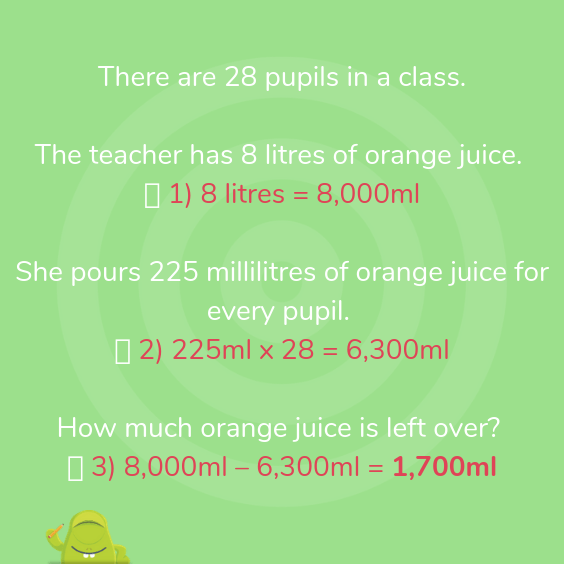
Solving a more complex word problem
Mara is in a bookshop. She buys one book for £6.99 and another that costs £3.40 more than the first book. She pays using a £20 notes. What change does Mara get?
- More than = add
- Using decimals means I will have to line up the decimal points correctly in calculations
- Change from money = subtract
See this example of bar modelling for this question:
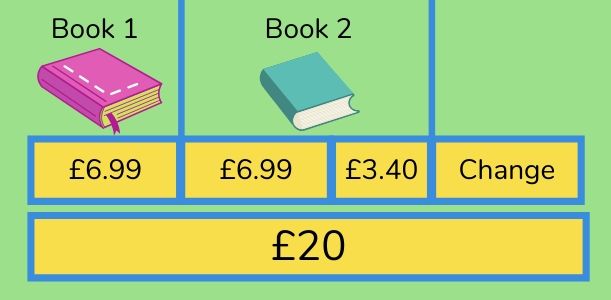
Now to put the maths to work using what we already know and what we’ve drawn to break down the steps.
Mara is in a bookshop.
She buys one book for £6.99 and another that costs £3.40 more than the first book. 1) £6.99 + (£6.99 + £3.40) = £17.38
She pays using a £20 note. What change does Mara get? 2) £20 – £17.38 = £2.62
Maths word problems for years 1 to 6
The more children learn about maths as the go through primary school, the trickier the word problems they face will become.
Below you will find some information about the types of word problems your child will be coming up against on a year by year basis, and how word problems apply to each primary year group
Throughout Year 1 a child is likely to be introduced to word problems with the help of concrete resources (pieces of physical apparatus like coins, cards, counters or number lines) to help them understand the problem.
An example of a word problem for Year 1 would be:
Chris is going to buy a cake for his mum which costs 80p. How many 20p coins would he need to do this?
Year 2 is a continuation of Year 1 when it comes to word problems, with children still using concrete maths resources to help them understand and visualise the problems they are working on
An example of a word problem for Year 2 would be:
A class of 10 children each have 5 pencils in their pencil cases. How many pencils are there in total?
With word problems for year 3 , children will move away from using concrete resources when solving word problems, and move towards using written methods. Teachers will begin to demonstrate the four operations such as addition and subtraction word problems, multiplication and division problems too.
This is also the year in which 2-step word problems will be introduced. This is a problem which requires two individual calculations to be completed.
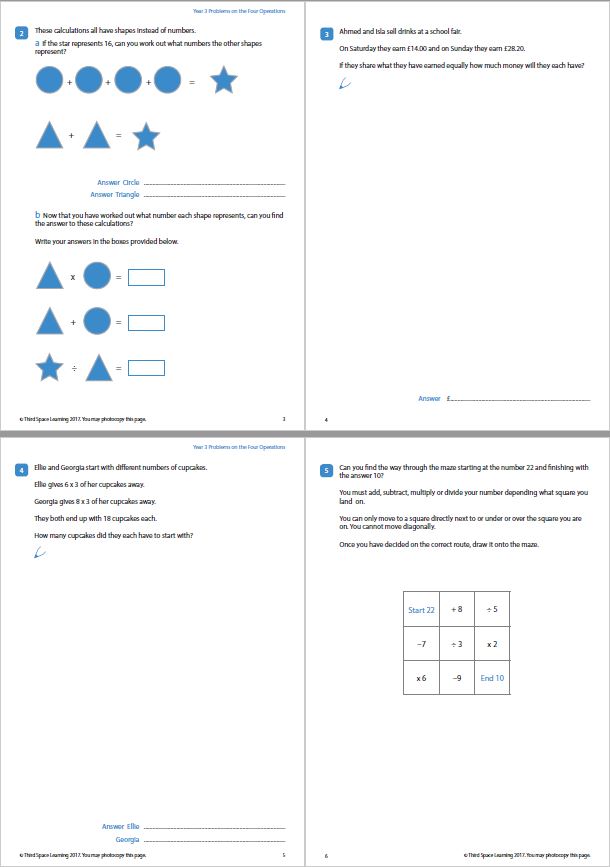
Year 3 word problem: Geometry properties of shape
Shaun is making 3-D shapes out of plastic straws.
At the vertices where the straws meet, he uses blobs of modelling clay to fix them together
Here are some of the shapes he makes:
One of Sean’s shapes is a cuboid. Which is it? Explain your answer.
Answer: shape B as a cuboid has 12 edges (straws) and 8 vertices (clay)
Year 3 word problem: Statistics
Year 3 are collecting pebbles. This pictogram shows the different numbers of pebbles each group finds.
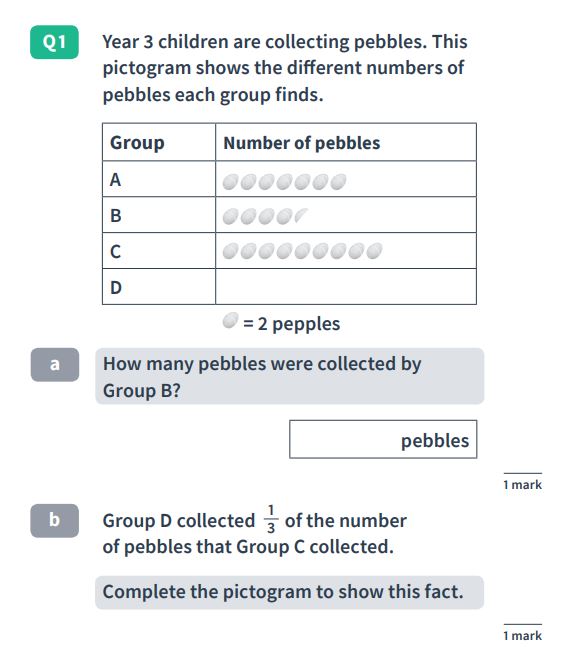
Answer: a) 9 b) 3 pebbles drawn
Top tip By the time children are in Year 3 many of the word problems, even one-step story problems tend to be a variation on a multiplication problem. For this reason learning times tables becomes increasingly essential at this stage. One of the best things you can do to help with Year 3 maths at home is support your child to do this. You can also help children while they are developing this skill by providing 100 squares to help them solve these word problems.
At this stage of their primary school career, children should feel confident using the written method for each of the four operations.
Word problems for year 4 will include a variety of problems, including 2-step problems and be children will be expected to work out the appropriate method required to solve each one.
Year 4 word problem: Number and place value
My number has four digits and has a 7 in the hundreds place. The digit which has the highest value in my number is 2. The digit which has the lowest value in my number is 6. My number has 3 fewer tens than hundreds. What is my number?
Answer: 2,746
One and 2-step word problems continue with word problems for year 5 , but this is also the year that children will be introduced to word problems containing decimals.
These are some examples of Year 5 maths word problems .
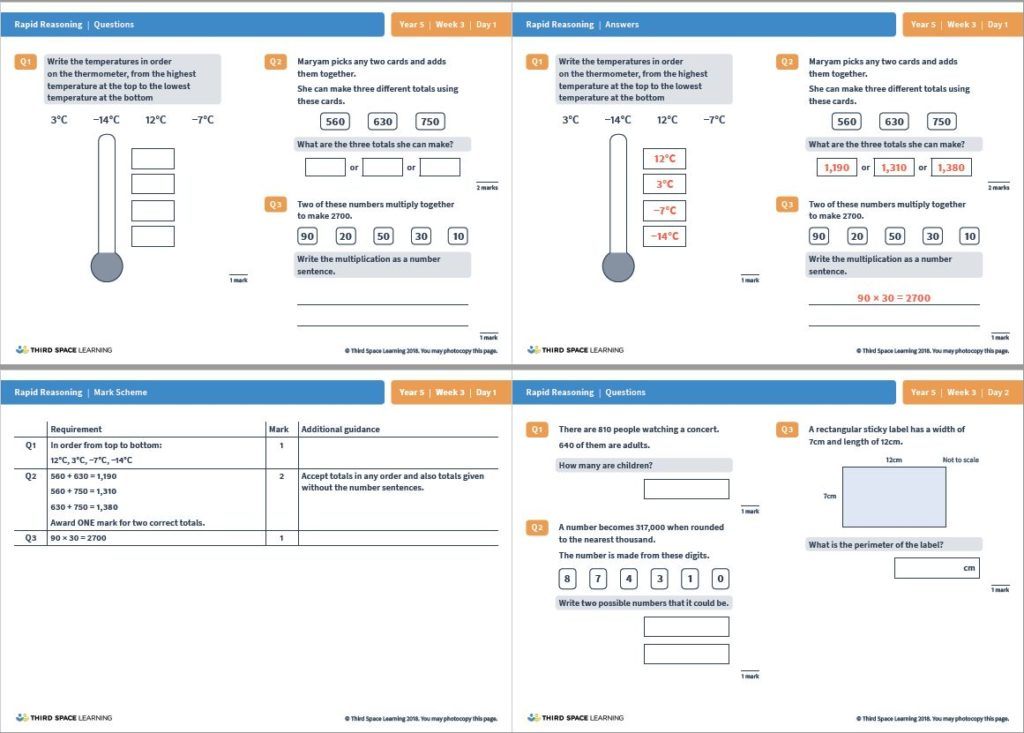
Year 5 word problem: Fractions, decimals and percentages
Stan, Frank and Norm are washing their cars outside their houses. Stan has washed 0.5 of his car. Frank has washed 1/5 of his car. Norm has washed 5% of his car.
Who has washed the most?
Explain your answer.
Answer: Stan (he has washed 0.5 whereas Frank has only washed 0.2 and Norm 0.05)
Word problems for year 6 shift from 2-step word problems to multi-step word problems. These will include fractions, decimals, percentages and time word problems.
Here are some examples of the types of maths word problems Year 6 will have to solve.
Year 6 word problem – Ratio and proportion
This question is from the 2018 key stage 2 SATs paper. It is worth 1 mark.
The Angel of the North is a large statue in England. It is 20 metres tall and 54 metres wide.
Ally makes a scale model of the Angel of the North. Her model is 40 centimetres tall. How wide is her model?
Answer: 108cm
Year 6 word problem – Algebra
This question is from the 2018 KS2 SATs paper. It is worth 2 marks as there are 2 parts to the answer.
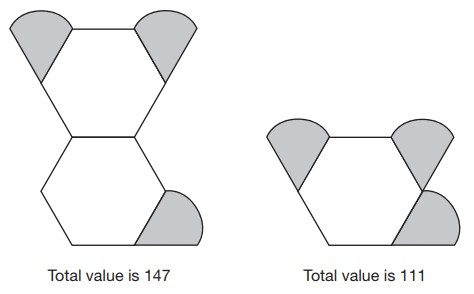
Amina is making designs with two different shapes.
She gives each shape a value.
Calculate the value of each shape.
Answer: 36 (hexagon) and 25 .
Year 6 word problem: Measurement
This question is from the 2018 KS2 SATs paper. It is worth 3 marks as it is a multi-step problem.
Answer: 1.7 litres or 1,700ml
Topic based word problems
The following examples give you an idea of the kinds of maths word problems your child will encounter for each of the 9 strands of maths in KS2.
Place value word problem Year 5
This machine subtracts one hundredth each time the button is pressed. The starting number is 8.43. What number will the machine show if the button is pressed six times? Answer: 8.37
Download free number and place value word problems for Years 3, 4, 5 and 6
Addition and subtraction word problem Year 3
In Year 3 pupils will solve addition word problems and subtraction word problems with 2 and 3 digits.
Sam has 364 sweets. He gets given 142 more. He then gives 277 away. How many sweets is he left with? Answer: 229
Download free addition and subtraction word problems for Years 3, 4, 5 and 6
Addition word problem Year 3
Alfie thinks of a number. He subtracts 70. His new number is 12. What was the number Alfie thought of? Answer: 82
Subtraction word problem Year 6
The temperature at 7pm was 4oC. By midnight, it had dropped by 9 degrees. What was the temperature at midnight? Answer: -5oC
More here: 25 addition and subtraction word problems
Multiplication and division word problem Year 3
A baker is baking chocolate cupcakes. She melts 16 chocolate buttons to make the icing for 9 cakes. How many chocolate buttons will she need to melt to make the icing for 18 cakes? Answer: 32
Multiplication word problem Year 4
E ggs are sold in boxes of 12. The egg boxes are delivered to stores in crates. Each crate holds 9 boxes. How many eggs are in a crate? Answer: 108
Download free multiplication word problems for Years 3, 4, 5 and 6
Division word problem Year 6
A factory produces 1,692 paintbrushes every day. They are packaged into boxes of 9. How many boxes does the factory produce every day? Answer: 188
Download our free division word problems worksheets for Years 3, 4, 5 and 6.
More here: 20 multiplication word problems More here: 25 division word problems
Free resource: Use these four operations word problems to practise addition, subtraction, multiplication and division all together.
Fraction word problem Year 5
At the end of every day, a chocolate factory has 1 and 2/6 boxes of chocolates left over. How many boxes of chocolates are left over by the end of a week? Answer: 9 and 2/6 or 9 and 1/3
Download free fractions and decimals word problems worksheets for Years 3, 4, 5 and 6
More here: 28 fraction word problems
Decimals word problem Year 4 (crossover with subtraction)
Which two decimals that have a difference of 0.5? 0.2, 0.25, 0.4, 0.45, 0.6, 0.75. Answer: 0.25 and 0.75
Download free decimals and percentages word problems resources for Years 3, 4, 5 and 6
Percentage word problem Year 5
There are 350 children in a school. 50% are boys. How many boys are there? Answer: 175
Measurement word problem Year 3 (crossover with subtraction)
Lucy and Ffion both have bottles of strawberry smoothie. Each bottle contains 1 litre. Lucy drinks ½ of her bottle. Ffion drinks 300ml of her bottle. How much does each person have left in both bottles? Answer: Lucy = 500ml, Ffion = 300ml
More here: 25 percentage word problems
Money word problem Year 3
James and Lauren have different amounts of money. James has twelve 2p coins. Lauren has seven 5p coins. Who has the most money and by how much? Answer: Lauren by 11p.
More here: 25 money word problems
Area word problem Year 4
A rectangle measures 6cm by 5cm.
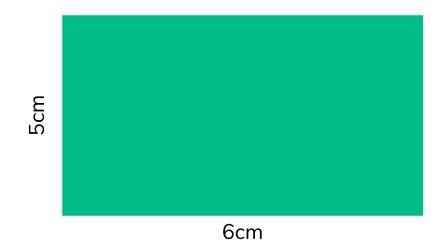
What is its area? Answer: 30cm2
Perimeter word problem Year 4
The swimming pool at the Sunshine Inn hotel is 20m long and 7m wide. Mary swims around the edge of the pool twice. How many metres has she swum? Answer: 108m
Ratio word problem Year 6 (crossover with measurement)
A local council has spent the day painting double yellow lines. They use 1 pot of yellow paint for every 100m of road they paint. How many pots of paint will they need to paint a 2km stretch of road? Answer: 20 pots
More here: 24 ratio word problems
Bodmas word problem Year 6
Draw a pair of brackets in one of these calculations so that they make two different answers. What are the answers?
50 – 10 × 5 =
50 – 10 × 5 =
Volume word problem Year 6
This large cuboid has been made by stacking shipping containers on a boat. Each individual shipping container has a length of 6m, a width of 4m and a height of 3m. What is the volume of the large cuboid? Answer: 864m3
In the KS1 SATs, 58% (35/60 marks) of the test is comprised of maths ‘reasoning’ (word problems).
In KS2, this increases to 64% (70/110 marks) spread over two reasoning papers, each worth 35 marks. Considering children have, in the past, needed approximately 55-60% to reach the ‘expected standard’, it’s clear that children need regular exposure to and a solid understanding of how to solve a variety of word problems.
Children have the opportunity to practice SATs style word problems in Third Space Learning’s online one-to-one SATs revision programme. Personalised to meet the needs of each student, our programme helps to fill gaps and give students more confidence going in to the SATs exams.
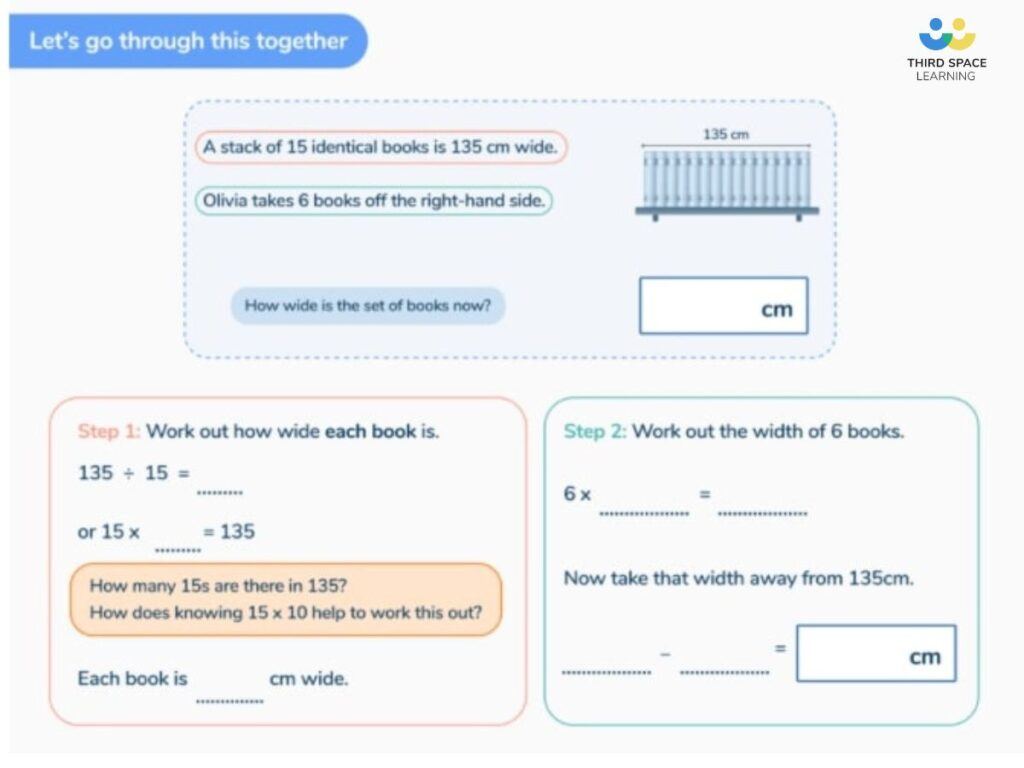
It can be easy for children to get overwhelmed when they first come across word problems in KS2, but it is important that you remind them that whilst the context of the problem may be presented in a different way, the maths behind it remains the same.
Word problems are a good way to bring maths into the real world and make maths more relevant for your child, so help them practise, or even ask them to turn the tables and make up some word problems for you to solve.
This article while written by a teacher for teachers is also suitable for those at home supporting children with home learning . More free home learning resources are also available.
Do you have pupils who need extra support in maths? Every week Third Space Learning’s maths specialist tutors support thousands of pupils across hundreds of schools with weekly online 1-to-1 lessons and maths interventions designed to address learning gaps and boost progress. Since 2013 we’ve helped over 162,000 primary and secondary school pupils become more confident, able mathematicians. Learn more or request a personalised quote for your school to speak to us about your school’s needs and how we can help.
Subsidised one to one maths tutoring from the UK’s most affordable DfE-approved one to one tutoring provider.
Related Articles

FREE Guide to Maths Mastery
All you need to know to successfully implement a mastery approach to mathematics in your primary school, at whatever stage of your journey.
Ideal for running staff meetings on mastery or sense checking your own approach to mastery.
Privacy Overview
Special March offer - 7 days free unlimited access to all premium content Try Premium
- Interactive
Word problems interactive.

Filter by Grade:
Filter by subject:.

- --> --> --> --> -->